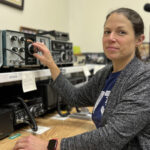Emergency preparedness is not boring – it is fun, interactive, and educational! In Illinois, preparing for a disaster involves games, parks, and day camps for children. With collaborative efforts and partnerships with a variety of community organizations, these valuable teaching opportunities instill family preparedness practices that last for generations.
In 2011, a survey conducted internally by McLean County Health Department (MCHD) and the Illinois State University Mennonite College of Nursing found that fewer than 50 percent of county residents had plans in place for emergencies. This finding was consistent with national trends – in response to a 2013 Ad Council study of 800 Americans, six out of ten admitted they had done no family emergency preparedness planning. To remedy this shortfall, the MCHD Bioterrorism and Emergency Preparedness (BT-EmPrep) team began looking for effective ways to get the message of emergency preparedness to families. One of the strategies under discussion involved increased outreach to children ages 6 to 12.
Planting & Growing Preparedness
A 2013 United Nations International Children’s Fund (UNICEF) study indicated that children represent 50 to 60 percent of those affected by emergencies and disasters. For this reason, preparedness organizations should consider targeting agencies providing children’s programs for collaboration on family-focused emergency preparedness training and education. This can serve a threefold purpose by: (a) influencing positive changes in the way families prepare for disasters; (b) planting seeds for a long-term commitment to safety and preparedness; and (c) providing children with emergency preparedness skills.
Evidence for successful children’s outreach programs can be found at the American Lung Association and the American Cancer Society. Both organizations have used children’s outreach programs to discourage tobacco use and promote smoking cessation among students and adults. According to the Centers for Disease Control and Prevention, since the year 1998, tobacco use among all students has fallen from approximately 37 to 18 percent. Additionally, over the same time period, the U.S. adult population’s tobacco use has dropped from approximately 25 to 19 percent.
Based on this model, the BT-EmPrep team concluded that educating children with an eye toward improving long-term family decision-making would produce positive results. Since the team normally works with adult organizations, this would require seeking new partnerships for collaboration, with agencies where children are the central focus. The BT-EmPrep team sought to convince potential partners that the outreach was flexible enough to meet their program goals, such as teaching child safety.
Partnerships – Laying the Groundwork
Overtures were initially made to a faith-based organization (FBO) day camp and a Vacation Bible School for autistic children. Both organizations welcomed the idea, which was promoted as a free, fun experience for the kids. Although there was a great deal of informal feedback testifying to the success of the program (conducted during June and July 2013), there was no formal tool to measure its overall effectiveness. With this in mind, the team decided to expand the 2014 outreach to non-FBOs and to create a feedback mechanism.
In January 2014, the team began laying the groundwork for the summer’s activities by contacting the Parks and Recreation Departments of the two largest towns in the jurisdiction, as well as the two town libraries and several local churches with Vacation Bible Schools. Based on the initial queries, a program manual and a letter template were created to emphasize that:
The program had been successful;
It offered long-term benefits not just to children, but to the community; and
The program was free – materials, instructions, and volunteers would be provided by the Health Department.
The last was intended to be a major selling point. Although the outreach did not focus on at-risk children, the team was actively seeking partnerships with agencies serving families that cannot afford many traditional summer activities.
The letter asked prospective collaborators for the following information to help the team better understand the agency’s needs:
How many children will be participating in our one-day program and what are their ages?
Will this require more than one day?
Which activity style best fits your organization’s needs? Game, room, or combination?
What timeframe will our volunteers have to implement the activities?
Is there a recommended staff/volunteer-to-child ratio per group that you recommend? We welcome your agency’s staff to assist in facilitating our activities, but we have the capability of providing volunteers.
Will your agency allow children to participate in surveys to help measure program success? McLean County Health Department is in the process of obtaining local grants to fund our summer outreach program. In order to qualify, we would like to distribute before and after questionnaires to the children participating in our program.
Keeping It Fun, Interactive & Educational
Once the collaborator agencies were identified, the decision was made to leave the design and implementation of the program in the hands of a college-aged AmeriCorps Member and a volunteer intern at MCHD. This allowed these creative and energetic young people to design an outreach program that was fun, interactive, and educational for the children attending the program. A trial run was conducted at a local home improvement store’s Family Preparedness event in January 2014 and again – based on informal attendee feedback – the event was a great success. Immediately following the event, the AmeriCorps member Cecilia Montesdeoca and MCHD volunteer intern Kera Spafford, began tweaking the plan and incorporating supply lists, instructions for the different games, and sample pre- and post-tests into the program manual.
For implementation, volunteers were recruited among high school and college students belonging to the local Junior American Red Cross Chapter. The 2014 program included the two venues from 2013 and added a local community parks and recreation day camp, effectively tripling the number of children reached. Outreach activities began on 28 June and concluded on 29 July.
Pre- and post-tests were split between age groups 6-9 and 10-12. The results from the parks and recreation program are shown in Figure 1. Red and blue indicate children who scored six or higher out of seven questions on the test. The improvement in scores among younger children jumped from 59 to 72 percent. For the older children, the improvement was from 60 to 78 percent. Several of the partner venues have asked for this program to be conducted in summer 2015.

Lessons learned from the 2014 summer outreach program:
Create a feedback tool to be administered to parents/caregivers, which will help measure the outreach’s impact on family emergency planning;
Plan for more youth volunteers, perhaps from the Boy Scouts as well as the junior Red Cross;
Begin planning the summer activities early;
Establish a calendar for initial contact; some agencies begin planning February, some not until April; and
Consider a rotation, with some partners being put on a three-year cycle
The BT-EmPrep team’s goal again for summer 2015 is to double the number of children in the program. Recruiting venues has helped immeasurably by the fact that not only do kids enjoy the program, but it is free for the collaborating agency and very inexpensive for the team. The cost to the Health Department was limited to minimal supervisory time on the part of the emergency preparedness coordinator, mileage for the volunteers, and a box of stickers. All other supplies were provided through donations or low-cost items on hand (construction paper, duct tape, and markers). Federal and state program funding no longer allows for the purchase of giveaways, so the MCHD graphic artist designed a colored sticker that was affixed to several flats of bottled water. This water was distributed to the children during program activities.
The most carefully designed children’s outreach will fail if it is not enjoyable. The BT-EmPrep team will continue to adapt the program based on comments from children and collaborator agency staff.

Shay Simmons
Shay Simmons grew up in southeastern Michigan. After her military service (USMC), she relocated to Illinois and has been the emergency preparedness coordinator for the McLean County Health Department since September 2009. She completed the Emergency Management Institute’s Professional Development Series (PDS) in December 2012, and is currently working on her Illinois Professional Emergency Manager certification.
-
Shay Simmonshttps://www.domesticpreparedness.com/author/shay-simmons

Ryan Easton
Ryan Easton is an AmeriCorps Member specializing in emergency preparedness for the McLean County Health Department in Bloomington, Illinois. Before accepting his position with AmeriCorps, Ryan served five years in the United States Army as a paratrooper. His tour of duty included two deployments in support of Operation Iraqi Freedom. He received his Bachelor of Science in biology from the University of Michigan, and is an admitted masters student at the University of Illinois – Chicago School of Public Health.
-
This author does not have any more posts.






